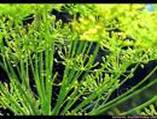| Kingdom | Plantae |
| Division | Magnoliophyta |
| Class | Magnoliopsida |
| Order | Apiales |
| Family | Apiaceae |
| Tribe | Cichorieae |
| Genus | Anethum |
| Species | A. graveolens |
| Binomial name | Anethum graveolens |
Other Common Names:
The other common names for this particular herb are dillby, dylle and thila.
History
Dill is commonly regarded as the Anethon of Dioscorides. It was well known in Pliny's days and is often mentioned by writers in the Middle Ages. The decoction of dill is a gallant expeller of wind. The name is derived, according to Prior's Popular Names of English Plants, from the old Norse word, dilla (to lull), in allusion to the carminative properties of the drug. As a drug it has been in use from very early times. It occurs in the tenth-century vocabulary of Alfric, Archbishop of Canterbury.

Description
Dill is a very attractive herb, with dark green feathery leaves, and yellow, umbrella-like flowers. The plant grows ordinarily from 2 to 2 1/2 feet high and is very like fennel, though smaller, having the same feathery leaves, which stand on sheathing foot-stalks, with linear and pointed leaflets. It is of very upright growth, its stems smooth, shiny and hollow, and in midsummer bearing flat terminal umbels with numerous yellow flowers, whose small petals are rolled inwards.


Range
It is usually grown in herb gardens or cultivated commer- cially because of the large demand for it, but its natural habitat is the Mediterranean countries, where it grows wild in cornfields. Dill originated in Eastern Europe. Zohary and Hopf remark that "wild and weedy types of dill are widespread in the Mediterranean basin and in West Asia."Dill is a hardy annual, a native of the Mediterranean region and Southern Russia. It grows wild among the corn in Spain and Portugal and upon the coast of Italy, but rarely occurs as a cornfield weed in Northern Europe.
Habitat
It is usually grown in herb gardens or cultivated commer- cially because of the large demand for it, but its natural habitat is the Mediterranean countries, where it grows wild in cornfields.
Cultivation
Successful cultivation requires warm to hot summers with high sunshine levels; even partial shade will reduce the yield substantially. It also prefers rich, well drained soil. The seeds are viable for 3-10 years. When grown on a large scale for the sake of its fruits, it may be sown in drills 10 inches apart, in March or April, 10 lb. of the seed being drilled to the acre, and thinned out to leave 8 to 10 inches room each way.The seed is harvested by cutting the flower heads off the stalks when the seed is beginning to ripen. In hot weather, threshing may be done in the field, spreading the sheaves on a large canvas sheet and beating out. The seed heads are placed upside down in a paper bag and left in a warm dry place for a week. The seeds then separate from the stems easily for storage in an airtight container.
Parts Used
The parts and the products generally used from this herb are seeds, herb and the oil.
Flowering Season
The flowering season for this particular herb is generally between mid to late summer.
Pests and Diseases
Dill does not have any serious pest or disease problems. However, phoma blight, rusty root, and stem rot have been reported. A unique quality of dill that makes it desirable for some gardeners, particularly those who grow lots of tomatoes and other types of vegetables is that it attracts some garden pests. Since dill grows quickly though, it seldom incurs much if any damage from such pests.
Horn Worms - brightly colored bluish-green caterpillar that grows very large, up to 4 inches long and feeds on dill leaves. This is the same variety of pest that is often found on tomatoes. Remove hornworms from dill by hand allowing pest control that is natural and does not harm the environment.
Parsley Worms - bright green caterpillar or butterfly larvae that feed on dill leaves. Since dill grows quickly though, these can be picked off by hand and placed on other plants, which allows control without use of pesticides.
Diseases - Dill, like many herbs is considerably resistant to many common plant diseases. However, dill can be affected by some of these diseases:
Alternaria Blight - Dill can be affected by this seed-borne disease, which transmits the Alternaria fungus affecting the entire plant. The fungus becomes active during the germination process of the dill seed and spreads throughout the entire plant causing leaves to become discolored and drop from the plant.
Aster Yellows - Entire dill crops can be destroyed by this disease, which is caused by phytoplasma and transmitted by pests such as aphids that hop from plant to plant. It destroys the chloroform in the leaves and causes deterioration stopping development of dill seeds.
Medicinal Applications
• Dill fruit and oil of Dill possess stimulant, aromatic, carminative and stomachic properties.
• Its most common use is in the preparation of Dill Water, which is a common domestic remedy for the flatulence of infants, and is a useful vehicle for children's medicine generally.
• Dill seeds were traditionally used to soothe the stomach after meals.
• The dill being boiled and drank, is good to ease swellings and pains.
Commercial Applications


• It is for flavouring soups, sauces, etc., for which purpose the young leaves only are required.
• The leaves added to fish, or mixed with pickled cucumbers give them a spicy taste.
• Dill vinegar, however, forms a popular household condiment. It is made by soaking the seeds in vinegar for a few days before using.
• The French use Dill seeds for flavouring cakes and pastry, as well as for flavouring sauces.
• Perhaps the chief culinary use of Dill seeds is in pickling cucumbers: they are employed in this way chiefly in Germany where pickled cucumbers are largely eaten.
• Dill seeds are used as a spice, and its fresh leaves, dill, and its dried leaves, dill weed, are used as herbs.
• Fresh and dried dill leaves are used as herbs.
• In Vietnam, dill is the important herb in the dish cha ca.
• Dill seed is used as a spice, with a flavor somewhat similar to caraway, but also resembling that of fresh or dried dill weed.
• Dill oil can be extracted from the leaves, stems and seeds of the plant.

Although several twigs of dill were found in the tomb of Amenhotep II, they report that the earliest archeological evidence for its cultivation comes from late Neolithic lake shore settlements in Switzerland. Traces have been found in Roman ruins in Great Britain. In Semitic languages it is known by the name of Shubit. The Talmud requires that tithes shall be paid on the seeds, leaves, and stem of dill. The Bible states that the Pharisees were in the habit of paying dill as tithe; Jesus is said to have rebuked them for tithing dill but omitting.
The name dill is thought to have originated from a Norse or Anglo-Saxon word 'dylle' meaning to soothe or lull, the plant having the carminative property of relieving gas. In the northeastern U.S. and adjoining parts of Canada, the seed of dill is sometimes known as "meeting-seed". This expression originates with the Puritans and Quakers, who would give their children dill seeds to chew during long church meetings, due to dill's mild hunger-suppressant qualities. In Vietnam, dill is named "thì lá". There exists a fable in which God accidentally names the plant "it is" (thì lá).
In the Middle Ages, dill was also one of the herbs used by magicians in their spells, and charms against witchcraft. In Drayton's Nymphidia are the lines: Therewith her Vervain and her Dill, That hindereth Witches of their Will.